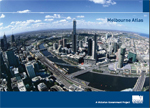Melbourne Atlas 2006 |

The Melbourne Atlas provides a comprehensive picture of how Melbourne is changing and the major trends that have shaped Melbourne over the last 50 years.
Melbourne is a complex and diverse place, and one that is changing in all sorts of ways.
Understanding how the city changes and the factors driving these changes - society, culture, economy, environment - will help all those involved and interested in Melbourne's future development.
With a focus on metropolitan Melbourne, the Atlas features 8 chapters: Melbourne's development; Melbourne's people; Housing; Working; Living; Equity; Learning; and Sustaining the Environment.
The Melbourne Atlas is a valuable tool for people in government, the private sector, research, education, place management and others who are interested in the factors shaping Melbourne or particular areas within Melbourne.
To order your copy of the Melbourne Atlas select from one of two sizes and contact one of the suppliers listed below.
Counter Sales
Ground Floor
356 Collins St
Melbourne 3000
Counter Sales
Ground Floor
8 Nicholson Street
East Melbourne 300
Melbourne, look at you now - The Age -
Royce Millar
August 21, 2006
MELBOURNE is a mobile city in more ways than one. Our ever-greater reliance on cars, the increased propensity to move job and home and a love affair with telecommunications are helping reshape a city that is almost unrecognisable from the metropolis of just 50 years ago.
Whereas fewer than half of Melburnians owned a car in 1950, almost 40 per cent of households now boast two or more. And where mobile telephones would have been little more than a sci-fi comic fantasy, now in most areas of Melbourne mobiles outnumber land lines.
A new snapshot of the city is contained in the first Melbourne Atlas, to be released by the State Government this week to help policymakers, planners, teachers and the public better understand the city in its physical, economic and social complexity - from housing data to shopping habits and attitudes to multiculturalism.
At 3.6 million, Melbourne's population is just half that of Paris, but the Victorian capital is twice the geographic size of France's and now occupies double the space it did when Daddy Cool recorded Eagle Rock in 1971.
Melbourne is a far cry from the staid, white-bread and six o'clock-closing city lampooned by Barry Humphries in the mid-1950s. Then the vast majority of the population lived within 10 kilometres of the GPO, most trips to work were by public transport and university was for the privileged.
The Atlas paints a picture of remarkable city growth and sprawl fuelled by postwar affluence that encouraged splurging on detached suburban homes, cars and consumerism. And it details the redrawing of the city's character through improved access to education and the lifestyle enhancements that come with multiculturalism.
"It (the Atlas) shows that for the most part, the quality of life in Melbourne has changed for the better, with increases in the cost of living offset by more schools and parks, higher education levels and incomes and better housing,"Planning Minister Rob Hulls said.
While the Atlas celebrates lifestyle improvements, it emphasises the challenges - especially environmental ones - that such abundance presents for the State Government.
Mr Hulls, for instance, noted the Atlas' finding that Melbourne had a much larger "ecological footprint"than most other cities in the world.
"As the population continues to grow, measures to conserve water, increase energy efficiency and reduce greenhouse gas emissions are becoming more important,"he said.
The Atlas tells a tale of a dynamic city constantly in a state of flux, shows how Melbourne is made up of many communities and how unevenly spread are the spoils of a wealthy society.
Whereas Melbourne's rich and poor were once divided north-south by the Yarra River, the Atlas reinforces the more recent view that its socio-economic divide is now between inner and outer Melbourne, senior government demographer Jeremy Reynolds says.
Once-downtrodden suburbs such as Collingwood and Richmond now report above-average shares of high-income earners, while Greater Dandenong has the lowest median household income - $841 a week. Less than 2 per cent of residents of leafy Brighton are unemployed, but the figure is 13.4 per cent for battling Broadmeadows.
A lack of public transport hits hard in outer Melbourne - less than 3 per cent of jobs are accessible in 40 minutes by public transport.
Mr Reynolds said the Atlas was the first of its kind to provide a comprehensive overview of this information. He said it would help the debate about Melbourne's future.
❊ Address ❊
℅ Naarm
⊜ Melbourne Atlas 2006 Melbourne 3000 View Map
✆ Telephone: (03) 9637 9441
❊ Web Links ❊
➼ Melbourne Atlas 2006
➼ Melbourne, look at you now - The Age
➼ 2030.2 - Melbourne ... A Social Atlas, 2001
➼ Department of Sustainability & Environment
Disclaimer: Check with the venue (web links) before making plans, travelling or buying tickets.
Accessibility: Contact the venue for accessibility information.
Update Page









